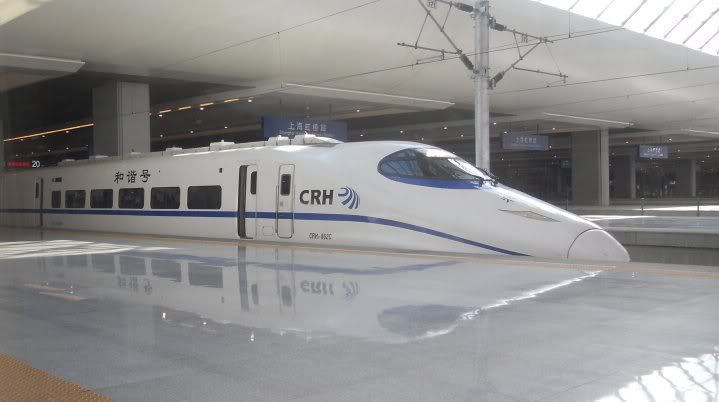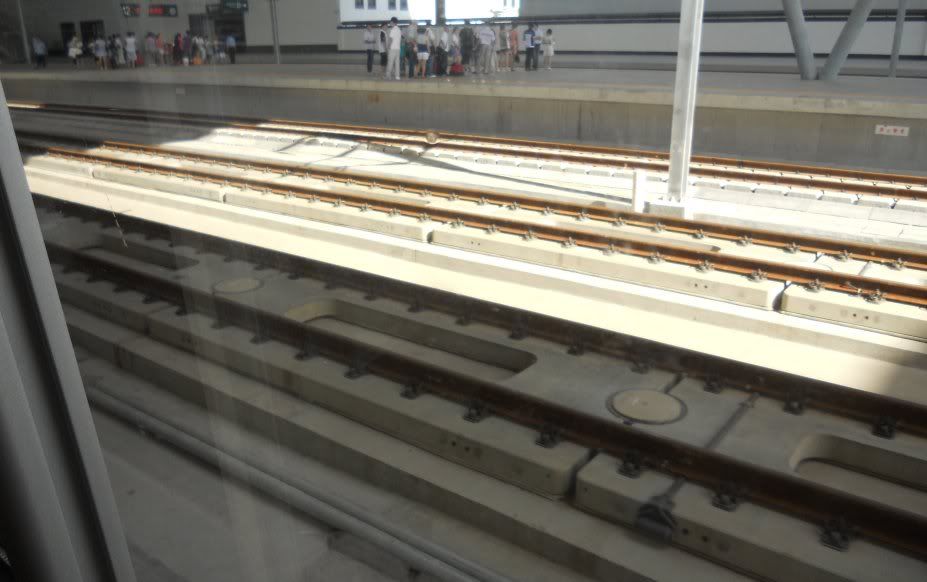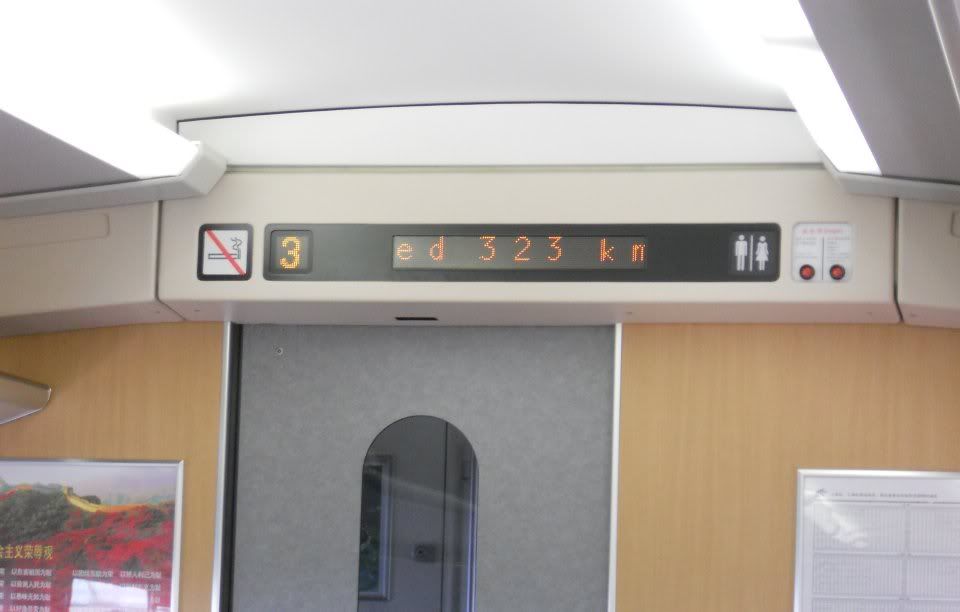
Posted on 07/25/2010 6:38:48 PM PDT by PugetSoundSoldier
There's a big push in some corners of the US transportation industry to "bring high speed rail to America". Visions of relaxed, latte-sipping trips over the nation, no lines for security, low cost trips are certainly heady ideas, but do they bear out? Let's take a critical, cold, calculating look at the reality of the situation.
As many know, I split my time between the US (Seattle, WA area) and Asia (predominantly Shanghai, China). China's been on a high speed rail building frenzy recently, and there are thousands of kilometers of line laid, with thousands more to come. Soon most of the larger Chinese cities in the East will be connected by high speed rail.
Just yesterday I rode one of these new marvels: the high speed rail line from Shanghai Hong Qiao (a behemoth of a transportation hub, consisting of an airport with two, 3400 meter runways, a bus terminal, a rail terminal, and a subway station) to Suzhou, a small town (well, by Chinese standards: only 6 million people) about 130 km away.
Hong Qiao is massive, even by Chinese standards. Not only are there 75 airline gates, but 36 long distance bus slots, 16 rail platforms, eight taxi stands (each capable of handling 800+ taxis at a time) and a full-size subway terminal. Soaring ceilings and highly polished marble and granite floors abound, and there is a good amount of space as befits China's 4th busiest airport/transportation terminal.
What does one of these new trains look like? Sleek and streamlined, as you would expect from a train capable of 300+ kilometers per hour:

These speedsters ride on some pretty specialized and dedicated rail lines, as you would expect:

Heavily bedded, full-length concrete foundations, and track ties every 20 cm. Absolute rigidity and stability is required for a train capable of such high speeds. And they do move right along:

Yes, that's 323 kilometers per hour, a hair over 200 miles per hour. It's no slouch in terms of speed! Fast, clean, relatively spacious transportation. And the ticket price of 41 RMB each way (about $6 USD) is quite cheap, too - nearly as cheap as the old, slower rail lines (which, at 26 RMB are a good discount, but take 50 minutes to cover the same distance we sped across in just 20 minutes).
So why do I say that high speed rail will not work in the US? One word:
Ridership
You see, I rode train G7130, which departed Hong Qiao on Sunday morning at 7:51 AM. And I rode train G7273 back on Sunday evening, which left Suzhou at 7:18 PM. And in each case, EVERY seat was taken, and it was standing-room-only at the ends of the cars.
Sixteen cars per train. Eighty five seats per car. And another 15-20 people standing in the baggage areas of each car. Over 1600 passengers on each train.
And there are 70 such trains a day between Suzhou and Hong Qiao. And every single one is full. Do the math - that is 112,000 riders per day on a single, 20 minute ride. And it's like that 7 days a week (remember, I rode on a Sunday and still had to buy my tickets a day in advance to guarantee a seat).
Close to 800,000 riders a week. Over 40 million a year on a single line. That's 25% more than rode ALL of Amtrak last year. And this is just a single line (not even the busiest - that title is reserved for Beijing to Tianjin, and Guangzhou to Shenzhen).
There are no discounts in China; you pay the full fare, no free tickets. That's $672,000 per day in revenue on that single train.
I talked a bit with with Wang Xiaoyan, the director of G7130 as we sped through the city. In her trademark skirt, black shoes, neatly pressed blouse, buttoned vest, and cap (with the proudly displayed "director" arm band), she provided a few details to this gao da lao wai (big and large foreigner):
China spent 23 billion RMB (about $3.4 billion USD) to deploy this stretch of track. With ridership of 35 million per year, and operating costs of 32 RMB per passenger, China expects to recover its investment in about 10 years, when the tracks need to be reworked (every 8-15 years you need to rebed and replace the tracks, to account for settling and shifting of the line).
In other words, China's doing this not because they have billions of people to move (which they do), but because it will not be an economic drain on the economy. It will cover its own costs, including maintenance.
Additionally, the construction costs are amazingly low - only $45 million per mile. Thanks to the cheap labor costs in China, and the incredibly flat terrain (Hong Qiao is at 3 meters elevation above sea level; Suzhou is at 5 meters - less than 7 feet difference, and it's completely flat between the two locations) China can build the rail for a low cost.
Consider the recent London-to-Edinburgh high speed rail line - $55 billion for 534 kilometers (note: the distance from London to Edinburgh is 331 miles, but the plan requires 1500 miles of line to make that distance a reality; you need to deploy more than just the lineal distance between locations). That's $166 million per mile, about 4 times the cost of that in China. Deploying high speed rail in the US will be much closer to the prices seen in the UK as compared to those in China, especially when you start to factor in the montainous and varied terrain in the US, as compared to most of Eastern China (and as a point of reference, Seattle's recent Link Light Rail had a cost of $179 million per mile, in line with the UK costs of deployment).
Given the plan for a 17,000 mile (27,000 kilometer) network in the US, we would see costs of $2.8 TRILLION to deploy this network (at UK line prices). A massive outlay of cash, orders of magnitude larger than that planned by China for its entire network (which already is the largest in the world, and growing rapidly).
And ridership will be lower, as well. Consider that a single segment of one line inside China eclipses all rail riders in the US. If we assumed that US ridership would increase by a factor of 10 - 300 million riders a year - and that the lines had a 25 year lifespan before being replaced (about twice what is realistic), we'd see that the per-rider capital costs alone would be $376 per trip. And this assumes 0% cost of money (interest free loans/bonds issued). No financing costs, and a 20X factor in the use of the line and we're still at close to $400 per rider per day in subsidies.
This does not include operating costs, either. Three Hundred Seventy Six dollars PER TRIP. Each of those 300 million trips each year, with a $376 subsidy tacked on.
When you run the numbers, it becomes painfully obvious why high speed rail should be shunned in the US - it simply does not make sense. We have too few people spread over too large an area, with too high of a deployment cost to make this anywhere near a reasonable approach to transportation in the US. It may make sense for a select few tiny lines (the famed NE corridor, for example), but as a realistic national network? The numbers just don't add up.
You want to build high-speed rail and a station or two? Cue the nimby's.
It would be cheaper to have China come over here and build it.
Can’t you just imagine a train like this running to Hamtramck or Kalamazoo from Detroit!
It makes your heart sing!
http://www.youtube.com/watch?v=9H9gA_Mu2tM
Very cool post. Thanks for taking the time.
One other point: obtaining right-of-way for rail (or anything else) is problematic and expensive in the US.
Not such a problem in China, I presume. ;-)
*LOL*
Yes and $10/rider/hour operation will be offset by $5 tickets! Ain’t government planning and operations grand?
You left out one factor in the high speed rail equation.
Property.
that land is owned by someone. the rail company will need to buy it from lots and lots of people. and guess what? Politicians LOVE to make money off of real estate.
When it starts to look like a public funded rail system is going to go through, all the dirty ratfinks in government will go around buying up the land and then sell it to the rail project for 4times what it’s worth.
AND THAT IS WHY these stupid projects get funded even when they don’t make any sense.
Choo Choo Willie!
Sorry Willie, doesn't compute.
LOL
High speed rail, the boondoggle that just keeps on taking.
Actually, China has eminent domain laws like the US, but they also pay for the property - at fair market value - when exercising that law.
Note the costs I used were based on the UK costs of building, which would also include purchase of private lands at a cost commensurate with the US.
It’s simply an economic black hole.
My company most of this summer is offering for us to telecommute (on a part time basis that is). I agree with that statement, I’m seeing a lot of companies moving their headquarters away from the city to the suburbs..
So why do I say that high speed rail will not work in the US? One word:
Ridership
Two words:
PEAK OIL
As global demand for oil exceeds global supply, the market will seek more fuel efficient modes of transportation. Passenger rail systems fulfill that market need and ridership will continuously increase.
Being from Chicago, every time I go back, I still can’t get used to the fact that people in the ‘Chicagoland’ area can go for years without ever needing to go to the Loop. They work, play, shop, live 30 miles from downtown. If they want something it’s farther away, not closer. Atlanta, Dallas/Ft. Worth, Houston, LA, if there is open land, the city dweller will move out into the open as soon as he can.
But, Willie can keep on dreaming...
For that family of 4, paying $240 round trip for their rides to Disneyworld, you could rent a full size car for a week. Easy choice, I think!
Peak Oil is a myth. The idea is frightening, and therefore very useful to those with an agenda to sell, but it is still a myth. Oil is being found everywhere, and is not running out.
Seattles Light Rail is now 1 YR old, and its still a failure. At the cost of $200,000 a Yard it is only carrying 6% of the amount of passengers the supporters said it would carry. And most of those would of taken another form of public transportation anyway. Also they neglected to put Parking at the train stops, thinking people would ride a bus to the stop. They don’t
Disclaimer: Opinions posted on Free Republic are those of the individual posters and do not necessarily represent the opinion of Free Republic or its management. All materials posted herein are protected by copyright law and the exemption for fair use of copyrighted works.